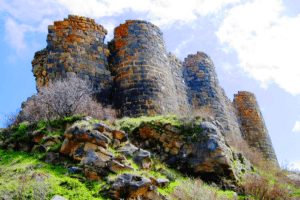The Amberd Fortress
The complex of Amberd is one of the best and the largest examples of Armenian fortress construction. The Amberd Fortress was built to the north of Byurakan Observatory in X century, at an altitude of 2300 m. The deep gorges at the junction of rivers Amberd and Arkashen protect it from two sides. The location of Amberd Fortress is at the site of an ancient fortress on the southern slopes of the Mount Aragats.
Amberd was a powerful fortress in medieval Armenia. The position of Amberd, as well as the cyclopean fortresses around it, confirm that the fortress existed as early as III-II BC.
History
This fortress existed during the Bronze Age and Urartian periods. Amberd used to be a summer residence for kings. The castle was built in the 7th century for the Kamsarakan family. With the time, a small outpost turned into a well-protected fortress. However, the Kamsarakans had to pass this castle to Pahlavuni, who made it their residence.
- The Amberd Fortress
- The Amberd Fortress
In the 11th century the great commander Vagram Pahlavuni, who was also the archimandrite of Ani, ordered to fortify the complex of Amberd and build there a church – Vagramashen. He built the Church Vagramashen in 1026 and it reached our days practically in its original state. Vahram also fortified the complex with thicker stone walls and added three bastions along the ridge of the Arkashen.
The Amberd Fortress had three construction periods: the Bagratounis, the Zakarians, and the Vachutians.
The Pahlavunis rivaled the Bagratouni royal house for power and also supplied a single line of Catholicos for 100 years. The fortress was their seat of power. In the 1070s Seljuks invaded Amberd and turned it into a military base.
In 1196 a joint-army of Armenians and Georgians led by General Zakareh Zakarian liberated the fortress. The Zakarians also liberated most of Armenia and fostered a new golden age. Amberd’s construction had structural reinforcement of the walls and the addition of 12th-13th-century renovations to the castle and outer buildings.
In 1215 the noble Vacheh Vachutian purchased Amberd. This Fortress became a key defensive site in that region until Mongols captured and destroyed this beautiful fortress. No later than a century, Vachutians reconstructed Amberd.
The church of Amberd
- Church
- The Vahramashen Church
- Church
As you saw before, Vahram Pahlavuni built the Vahramashen church(or Surp Astvacacin) in 1026. The S.Astvacacain is at the heart of the fortress. The S.Astvacacin is a cruciform type church. There are four two-story chambers in the corners in the church. It is the first church that has two-story chambers. The church made with local basalt stone. There are 2 entrances to the church, one on the north side and one on the south. The church has no windows, only four small apertures in the bottom and four apertures on the dome’s drum. The architect of the church is not Vahram Pahlavuni. The architect who designed the gorgeous Marmashen church built Vahramashen or S.Astvacacin.
Architecture
The architecture of Amberd is simple. Its walls’ constructions include massive basalt blocks tiles that once served to protect from shells and siege weapons. People have preserved the foundations of construction and few walls inside the fortress. Like the walls of the lower 2 floors and in certain places on the third floor. It is a large 3-storey building. There were five rooms in the first and second floors. On the third floor, there was the reception areas and private rooms for its royal inhabitants. The windows of the palace are from the side that looks to the fortress. This had 2 advantages: firstly, the fortress protected the windows and, secondly, by looking to the sun, they could receive more light and heat.
Apart from that, archaeological research discovered some mysteries from its past. The most interesting finding in Amberd was Armenian lavash. It is dating back to the 12th century that was still edible. During the excavations, people found numerous underground walkways leading to rivers. It became evident that there used to be a water-supply system. No fortress ever existed without solving the problem of water supply. Water was transmitted from a distance of 4-5 km with clay pipes, hot water – with iron pipes.
This is where the water went to the bath and the rest of the fortress. The Bath House was built in X-XI centuries. At that times the Bath House had used hypocaust heating as had originated in Roman times to heat the floors. This House has hewn stones, a small cloakroom, a large bathroom, and heating equipment accommodating the water boiling pot. The water pipes are perfect. They were in side by side position and connected by an iron bridge.
The road leading to Amberd
- The Vahramashen church in winter
- The Amberd Fortress in winter
This unique site is located 50km from Yerevan. There is only one serpentine road leading to it that passes through mountains. That is why it is impossible to get there in winter when everything is white and snowy.
That road is uninhabited and also has gently sloping hills with the occasional shepherd and beekeeper, many wildflowers and great views. The Amberd Fortress is not only a popular destination in Armenia, but it definitely is a gem of the medieval architecture of the Caucasus.















Leave a Comment